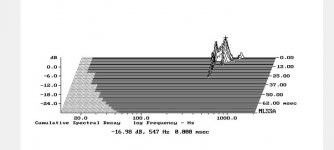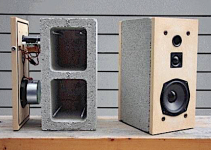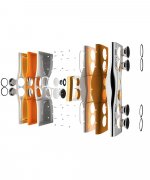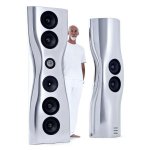How can we compare this to a properly made Baltic birch box of the same size?

Attachments
Last edited:
I agree. Unless everything is identical in every way, it’s impossible to prove that one way is better or worse. That’s up to the manufacturer to prove. Rich people like them for the status, so Magico doesn’t care whether it’s ultimately better or not
- what length would one go to prove themselves the best? Most manufacturers rather tell you than show you...thats called hiding....where theres smoke, theres fire.That’s up to the manufacturer to prove.
I'm not saying aluminum isn't better....How much better is the point.
Last edited:
Magico sounds good and healthy. No gimmick, no hype despite of its image. Price is, well, more than I can pay. 🙂
Camplo
I agree with that statement too, but if they did do everything perfectly to prove it and did, how could you know for sure. Lying manufacturers abound
I agree with that statement too, but if they did do everything perfectly to prove it and did, how could you know for sure. Lying manufacturers abound
I wasn't tempted to open that debate, the only thing worth talking about regarding them is the enclosure if you ask me. The above chart looks pretty quiet I just wonder how quiet a properly braced cab of baltic birch compares.
Impressive looking, but nowhere near efficient enough for me for serious listening. 🙁
You won't hear me disagree with that.
It is however a completely different can of worms... an expensive can of worms...
MDF is bad for anything but subwoofers. Its just cheap heavy junk, unsuitable for high end fullrange designs without extensive damping and reinforcement. High grade marin plywood is by far the best cabinet material with the best compromise in stiffness and internal dampening. The novelty of using compromised materials for building enclosures has worn off for me. I would rather use tried and true good old marine birch plywood to get predictable results. Besides, you could always cover the enclosure with sheet aluminum or other material if you want that look.
I tested these materials here. The Russian birch ply was essentially the same as the MDF except at 900hz were the MDF had a real problem that the ply did not. The primary resonances were equally bad and there is no way I would spend the money I did for that Russian birch in the future. Not when there were much cheaper CLD methods that are easy to construct, like the 1/4" MDF glued together with Weicon Flex 310M adhesive.



Last edited:
Augerpro
The work you have done is absolutely epic. You provide an invaluable resource. Thank you!
The work you have done is absolutely epic. You provide an invaluable resource. Thank you!
augerpro - did you by any chance test concrete? I raised the idea of including concrete in a previous post. I've just been looking at cinder blocks which can make an interesting "bookshelf" size 2 way, though you wouldn't exactly put it on a shelf.
Ever since I made a pair of concrete speaker cabinets when I lived in Norway I've been a fan. Haven't touched the stuff recently but I've been researching ready-made solutions like planter pots in 1 cu ft size. I just came across something brilliantly simple, so easy I just have to do a build. It would be about a day's work. Here's the idea:
Cinder Speakers Turn Concrete Blocks Into High Fidelity
Ballou Projects
Cinder Block Speakers | Parts Express Project Gallery
Classix II MT Bookshelf Speaker Kit with Baffle Only
And here's the hollow concrete blocks. The walls are 35mm thick. They weigh 26kg. I calculate each chamber as 4.5litres (145x145x215). They could be combined if an angle grinder could remove a bit of the centre section.
215mm Hollow 7N Concrete Block | Lawsons Lawsons, but also Jewsons etc etc
This looks the right size for a BBC clone LS3/5A. Plenty of kits available for that. Front and back could be baltic birch, MDF or 12mm aluminium. Or a composite of ply/MDF and aluminium in a constrained layer. Or whatever.
Ever since I made a pair of concrete speaker cabinets when I lived in Norway I've been a fan. Haven't touched the stuff recently but I've been researching ready-made solutions like planter pots in 1 cu ft size. I just came across something brilliantly simple, so easy I just have to do a build. It would be about a day's work. Here's the idea:
Cinder Speakers Turn Concrete Blocks Into High Fidelity
Ballou Projects
Cinder Block Speakers | Parts Express Project Gallery
Classix II MT Bookshelf Speaker Kit with Baffle Only
And here's the hollow concrete blocks. The walls are 35mm thick. They weigh 26kg. I calculate each chamber as 4.5litres (145x145x215). They could be combined if an angle grinder could remove a bit of the centre section.
215mm Hollow 7N Concrete Block | Lawsons Lawsons, but also Jewsons etc etc
This looks the right size for a BBC clone LS3/5A. Plenty of kits available for that. Front and back could be baltic birch, MDF or 12mm aluminium. Or a composite of ply/MDF and aluminium in a constrained layer. Or whatever.
Attachments
If I'm not mistaken, if one hangs the common cinder-block in free space & strikes it with say, a long piece of metal, it will ring a resonant frequency.
If the little woofer frequency range is within this resonant frequency, it will set the enclosure in motion.
As such, this frequency would have to be damped out.
Perform an experiment to confirm or deny this theory...a simple AF generator on your computer...listen to the two side by side to try to match the frequencies you're hearing.
----------------------------------------------------------------------Rick.......
If the little woofer frequency range is within this resonant frequency, it will set the enclosure in motion.
As such, this frequency would have to be damped out.
Perform an experiment to confirm or deny this theory...a simple AF generator on your computer...listen to the two side by side to try to match the frequencies you're hearing.
----------------------------------------------------------------------Rick.......
Interesting... I have not seem an aluminium profile that large before...
I have worked with PVC pipe.
You could consider damping it by a bitumen sheet with an aluminium backing. This is the most effective form of damping called constraint layer damping. Look for stuff that car installers use. like this.
https://www.parts-express.com/Sonic...r-Sound-Damping-Sheets-31.5-x-18.12-4-268-046
How do you intend to seal the top and bottom?
What I did with my PVC project was seal the bottom with plastic vinyl, then pour in potting compound. Or you can use epoxy and such and maybe fill it up with gravel and sand...
Oon
I have worked with PVC pipe.
You could consider damping it by a bitumen sheet with an aluminium backing. This is the most effective form of damping called constraint layer damping. Look for stuff that car installers use. like this.
https://www.parts-express.com/Sonic...r-Sound-Damping-Sheets-31.5-x-18.12-4-268-046
How do you intend to seal the top and bottom?
What I did with my PVC project was seal the bottom with plastic vinyl, then pour in potting compound. Or you can use epoxy and such and maybe fill it up with gravel and sand...
Oon
How can we compare this to a properly made Baltic birch box of the same size?
You can't directly compare them because you can't have a bare alu enclosure the same way you can have a bare plywood box.
--> In practice, alu ends up as a shiny skin on top of a complex mass of bracing and damping.
--> Almost any composite material (or laminate) is acoustically better than a monolithic material.
IMO, using bamboo plywood as the skin layer is quite comparable to a skin of alu.
6061-T6 Aluminum vs. Bamboo Plywood :: MakeItFrom.com
They have the same strength:weight ratio, but bamboo has good self damping.
Which is the better choice?
Probably comes down to price, availability and aesthetic preference.
anybody knows more about these?
surprised these haven't come up yet - KEF Muon. The "exploded view" shows a lot of internal construction but no information whatsoever about materials, layering etc - anybody knows more?
surprised these haven't come up yet - KEF Muon. The "exploded view" shows a lot of internal construction but no information whatsoever about materials, layering etc - anybody knows more?
Attachments
Augerpro
The work you have done is absolutely epic. You provide an invaluable resource. Thank you!
Yes! This information will be invaluable when everyone intends to build braceless enclosures 🙄
Yes! This information will be invaluable when everyone intends to build braceless enclosures 🙄
In the next round I'll be adding braces to a couple of the high performers to see if they continue to perform well. BTW you should look at my results with the CLD braces. Thank you for your kind support.
Last edited:
Augerpro
I look at the work you’ve done so far as somewhat of a materials science course. The obvious next step, like you said, is the application of more cabinet bracing on the highest performing materials. I love the high sheer CLD bracing scheme you’re using in these tests!
I look at the work you’ve done so far as somewhat of a materials science course. The obvious next step, like you said, is the application of more cabinet bracing on the highest performing materials. I love the high sheer CLD bracing scheme you’re using in these tests!
Hi,
What happens if the layers have no constraint : i.e. not glued between them, sort of box inside box concept but not air proof : just here to break the wave lengths for reducing their frequency and energy into heat ? Are the vibration of the outside final layers, baffles, bigger ?
Same: what happens if we include a bracing that is not glued to the internals walls .For instance a bracing wood structure with foam everywhere , laying on a rubber pad? Or does the bracing have to couple two opposite walls and distributing internal vibration of the braces into them ?
I'm more and more thinking to something than can both seal the front baffle from the box while having a sealing that is air proof of course for keeping the load ! It should make all the material hassle choice about the box disappear, but for the front baffle of course ! One should look at the first white model Avanguarde outside material choice for the front baffle.
When I read : concrete, metal, stones, synthetic stones for kitchen plans, people seems to forget they don't need only a stiff cabinet but also one which has internal loss at several wave length and spl! : not a bell that ring high at one frequency.
Which is smart with Magico is the industrial ease to shape and assemble a metal structure and paint it : it's way cheaper and faster than any other process and can be outsourced, but maybe molding that ask expensive tools (Vivid Audio, B&W for the medium round enclosure. Mark & Daniel uses aluminum, but their loudspeaker are not big width walls.
I miss the old days when people made Onken with sand between walls with an internal lead layer in between.
My guess is bamboo parquets layers with a carefully chosen glue is better than any aluminum cabinet for sound, but ok it looks less cool ! 😀
What happens if the layers have no constraint : i.e. not glued between them, sort of box inside box concept but not air proof : just here to break the wave lengths for reducing their frequency and energy into heat ? Are the vibration of the outside final layers, baffles, bigger ?
Same: what happens if we include a bracing that is not glued to the internals walls .For instance a bracing wood structure with foam everywhere , laying on a rubber pad? Or does the bracing have to couple two opposite walls and distributing internal vibration of the braces into them ?
I'm more and more thinking to something than can both seal the front baffle from the box while having a sealing that is air proof of course for keeping the load ! It should make all the material hassle choice about the box disappear, but for the front baffle of course ! One should look at the first white model Avanguarde outside material choice for the front baffle.
When I read : concrete, metal, stones, synthetic stones for kitchen plans, people seems to forget they don't need only a stiff cabinet but also one which has internal loss at several wave length and spl! : not a bell that ring high at one frequency.
Which is smart with Magico is the industrial ease to shape and assemble a metal structure and paint it : it's way cheaper and faster than any other process and can be outsourced, but maybe molding that ask expensive tools (Vivid Audio, B&W for the medium round enclosure. Mark & Daniel uses aluminum, but their loudspeaker are not big width walls.
I miss the old days when people made Onken with sand between walls with an internal lead layer in between.
My guess is bamboo parquets layers with a carefully chosen glue is better than any aluminum cabinet for sound, but ok it looks less cool ! 😀
Last edited:
- Home
- Loudspeakers
- Multi-Way
- Aluminium speaker cabinets



